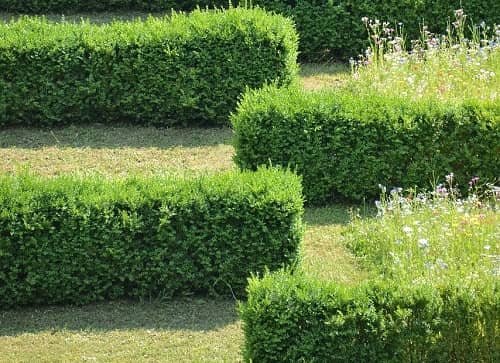How to grow hedges easily in 9 steps is given below.
Selection of plants for a hedge
Usually, different shrubs are used to making a desirable hedge. The plants for hedge making are selected according to their height and spread, growth rate, suitability to soil and climate, and response to pruning or clipping operation. For selecting the plants for a hedge, the following characteristics should be kept in mind-
- The plant should be bushy, thick-textured, and quick growing in the habit.
- It should withstand pruning to maintain shape.
- The plants should be easily propagated through stem cutting or seeds.
- It should withstand drought or any other adverse condition.
- It should not be liked by the cattle.
- It should not attract reptile animals in any case.
How to grow hedges (cultivation procedure)

For successful cultivation of hedges, different types of works are to be undertaken stage-wise. It includes land preparation, planting, manuring, watering, pruning, and other intercultural operation, etc. mentioned here under-
1. Preparation of land:
Hedges grow in different soil, but the soil should be fairly deep, fertile, and well-drained for better growth and development. The land should be plowed up to the depth of 45cm. To make a good growth of ornamental hedge, a trench of about 60-70cm deep and 45-60cm wide should be dug up and left open under the sun for 15 days to kill or destroy the harmful diseases and pests heat of scorching sunlight. Then, the trench should be refilled with treated soil and organic manure like well-decomposed cow dung or FYM.
2. Time of planting:
The best time for planting hedge is the rainy season during July-August (The monsoon season in the USA in the months of July, August, and September). When there is sufficient rainfall and high atmospheric humidity, planting can be done easily. Planting can also be done during February-March if there is a good water supply.
3. Method of planting:
Rooted cuttings or seeds are used as planting materials. The hedge should be planted at a spacing of 75-90cm. Whereas for dwarf hedges, the spacing should be 20-30cm. The trees should be planted 2-3m apart. To make a good dense hedge, planting should be done by a triangular system. For hedge planting, 9 plants per meter should be kept in a row, if planted singly 10 cm apart and 12 plants in a double row if planted 15cm apart.
4. Manuring:
Usually, the hedges receive little attention till they remain thin. Then they are pruned heavily in the rainy season. After that manuring is needed. The following doses of manures and fertilizer are applied-
- Superphosphate: 50g
- Bone meal: 50g
- Potassium sulfate: 15g
- Ammonium sulfate: 50g (per 2 m after 4-6 months)
5. Application of water (Irrigation):
Water requirement depends on the type of soil, the season of growth, etc. During the rainy season usually, no irrigation is required. But during hot and dry weather, the water requirement is high. During winter, hedges should be watered once in 10-15 days intervals, and during summer, it would be at seven days intervals. In light soil, the water requirement is more frequent than the heavy soils.
6. Weeding:
Weeds are very harmful as they compete with the hedge plants for nutrients, water space, light, etc. Hence the weeds should not be allowed to grow. They should be removed from the field whenever noticed.
7. Pruning:
When the hedge plants attain a height of about 15cm, they should be topped back to 10cm height with the help of garden shears. This will encourage the production of several side shoots on each plant. If such topping is not done and the plants are kept untouched, hedges will not be dense, and compact topping is continued till the plants achieve the desired height and shape. In the rainy season, frequent pruning is required because the plants make faster growth than in another season.
8. Propagation
The majority of the hedges are propagated by cuttings, but where seed can be obtained, the cost of raising a large number of plants is considerably reduced.
9. Sowing of hedge seeds
Sowing of hedge seed should be done in a nursery whenever possible. For the sowing of hedge seeds, the following rates are used according to the plant categories-
| Name of plants | Seed rate |
| Duranta | 1kg/100m |
| Inga dulcis | 1kg/100m |
| Sesbania | 150gm/100m |
| Lawsonia | 250 gm/100m |
| Henna plant | 250gm/100m |
